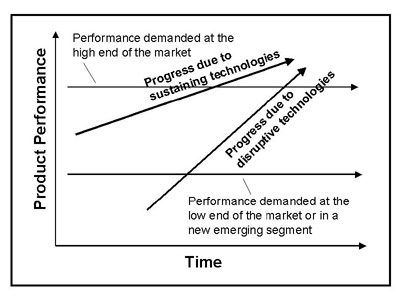Difference between revisions of "Disruptive Technology"
(Created page with "'''Content Coming Soon'''") |
(Disruptive technologies are "innovations that result in worse product performance, at least in the near term." They are generally "cheaper, simpler, smaller, and, frequently, more convenient to use.") |
||
| Line 1: | Line 1: | ||
| − | ''' | + | The term disruptive technology was coined by Clayton M. Christensen and introduced in his 1995 article Disruptive Technologies: Catching the Wave which he cowrote with Joseph Bower. He describes the term further in his book The Innovator's Dilemma. Christensen describes two types of technologies: sustaining technologies and disruptive technologies. Sustaining technologies are technologies that improve product performance. These are technologies that most large companies are familiar with; technologies that involve improving a product that has an established role in the market. Most large companies are adept at turning sustaining technology challenges into achievements. Christensen claims that large companies have problems dealing with disruptive technologies. Disruptive technologies are "innovations that result in worse product performance, at least in the near term." They are generally "cheaper, simpler, smaller, and, frequently, more convenient to use." Disruptive technologies occur less frequently, but when they do, they can cause the failure of highly successful companies who are only prepared for sustaining technologies. Disruptive technologies cause problems because they do not initially satisfy the demands of even the high end of the market. Because of that, large companies choose to overlook disruptive technologies until they become more attractive profit-wise. Disruptive technologies, however, eventually surpass sustaining technologies in satisfying market demand with lower costs. When this happens, large companies who did not invest in the disruptive technology sooner are left behind. This, according to Christensen, is the "Innovator's Dilemma."<ref>What is Disruptive Technology? [http://web.mit.edu/6.933/www/Fall2000/teradyne/clay.html MIT]</ref> |
| + | |||
| + | |||
| + | [[File:Disruptivetechnology.JPG|450px|Disruptive Technology]]<br /> | ||
| + | source: [http://web.mit.edu/6.933/www/Fall2000/teradyne/clay.html MIT] | ||
| + | |||
| + | |||
| + | In his sequel with Michael E. Raynor, The Innovator's Solution, Christensen replaced the term disruptive technology with [[Disruptive_Innovation|disruptive innovation]] because he recognized that few technologies are intrinsically disruptive or sustaining in character; rather, it is the business model that the technology enables that creates the disruptive impact.<ref>Disruptive Innovation on [https://en.wikipedia.org/wiki/Disruptive_innovation Wikipedia]</ref> | ||
| + | |||
| + | |||
| + | ===References=== | ||
| + | <references /> | ||
| + | |||
| + | |||
| + | |||
| + | ===Further Reading=== | ||
| + | *Disruptive technologies: Advances that will transform life, business, and the global economy [http://www.mckinsey.com/business-functions/business-technology/our-insights/disruptive-technologies McKinsey & Co] | ||
| + | *The 10 Most Disruptive Technologies of 2015 [http://www.inc.com/lisa-calhoun/the-top-10-most-disruptive-technologies-of-2015.htmlInc.com Inc.] | ||
| + | *Guide to 12 Disruptive Technologies [http://www.intelligenthq.com/technology/12-disruptive-technologies/ IntenlligentHQ] | ||
| + | *Disruptive vs. Sustained Technologies [http://www.evaluationengineering.com/disruptive-vs-sustained-technologies.php Evalualtion Engineering] | ||
Revision as of 15:49, 21 December 2018
The term disruptive technology was coined by Clayton M. Christensen and introduced in his 1995 article Disruptive Technologies: Catching the Wave which he cowrote with Joseph Bower. He describes the term further in his book The Innovator's Dilemma. Christensen describes two types of technologies: sustaining technologies and disruptive technologies. Sustaining technologies are technologies that improve product performance. These are technologies that most large companies are familiar with; technologies that involve improving a product that has an established role in the market. Most large companies are adept at turning sustaining technology challenges into achievements. Christensen claims that large companies have problems dealing with disruptive technologies. Disruptive technologies are "innovations that result in worse product performance, at least in the near term." They are generally "cheaper, simpler, smaller, and, frequently, more convenient to use." Disruptive technologies occur less frequently, but when they do, they can cause the failure of highly successful companies who are only prepared for sustaining technologies. Disruptive technologies cause problems because they do not initially satisfy the demands of even the high end of the market. Because of that, large companies choose to overlook disruptive technologies until they become more attractive profit-wise. Disruptive technologies, however, eventually surpass sustaining technologies in satisfying market demand with lower costs. When this happens, large companies who did not invest in the disruptive technology sooner are left behind. This, according to Christensen, is the "Innovator's Dilemma."[1]
source: MIT
In his sequel with Michael E. Raynor, The Innovator's Solution, Christensen replaced the term disruptive technology with disruptive innovation because he recognized that few technologies are intrinsically disruptive or sustaining in character; rather, it is the business model that the technology enables that creates the disruptive impact.[2]
References
Further Reading
- Disruptive technologies: Advances that will transform life, business, and the global economy McKinsey & Co
- The 10 Most Disruptive Technologies of 2015 Inc.
- Guide to 12 Disruptive Technologies IntenlligentHQ
- Disruptive vs. Sustained Technologies Evalualtion Engineering

